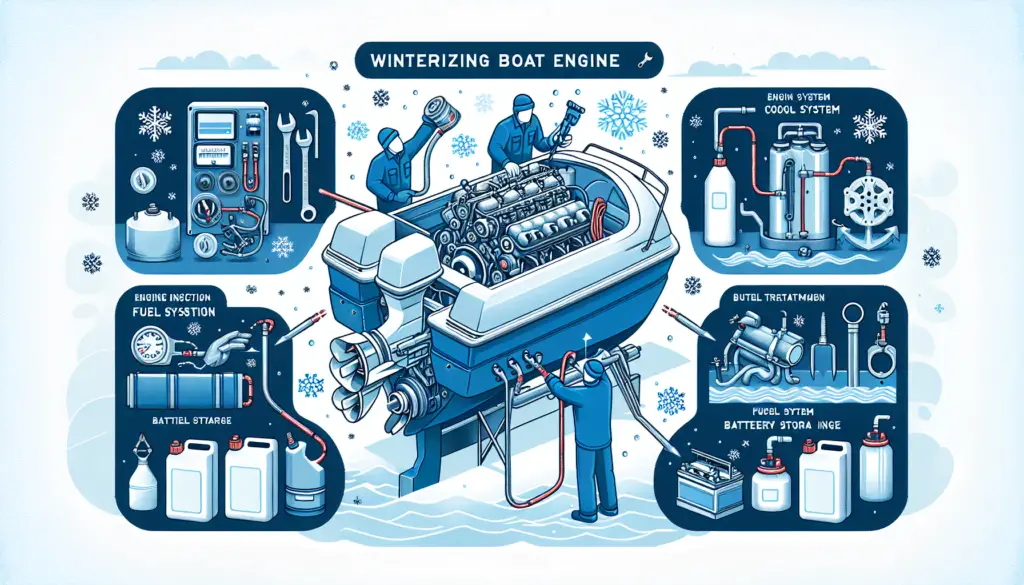As the winter season approaches, it becomes crucial to store your boat engines properly in order to ensure they’re ready to roar back to life in the spring. This article “Best Practices for Winter Storage of Boat Engines,” takes you through an easy and effective step-by-step process on how to perfectly prepare and store your boat engines for the winter period. We assure, it will make your off-season storage a breeze and offer a flawless beginning when the boating season comes around.

Understanding the Need for Winter Storage
There may be no better way to spend a summer day than out on the water. However, why does winterizing your boat engine become so crucial when the summer fades away? Allow me to explain.
Identifying the Issues with Weather Changes
As the seasons change, so do the conditions your boat engine operates in. Winter brings with it factors such as freezing temperatures, rain, snow, moisture, and humidity which can all wreak havoc on your boat engine. These conditions can lead to rust, corrosion, parts freezing and cracking, and even engine failure.
Coping with Freezing Temperatures
Freezing temperatures can create multiple problems. Water, when it freezes, expands, which can lead to pipes and other components cracking or breaking. Also, if there is fuel or water left in the engine, it can freeze, expand, and cause internal damage that may require expensive repairs down the line.
Impact on Boat Engines During the Winter Season
Unless properly cared for, your boat engine is vulnerable during the winter season. Essential parts like the engine block, exhaust manifolds, or the gear case can crack if they freeze. Such significant damages will substantially lower the lifespan of the engine and rack up repair costs.
Preparing the Engine for Storage
As the saying goes, “An ounce of prevention is worth a pound of cure.” A bit of preparation can go a long way in preventing damage to your boat engine during the winter.
Cleaning and Servicing the Engine
Before you put the boat engine into storage, give it a good clean and service. Remove any dirt, grime, oils, or barnacles that might have accumulated over the summer season. Doing this not only improves the engine’s efficiency but also prevents corrosion while kept in winter storage.
Draining and Replacing Fluids
Next, drain all the fluids from the engine–water, oil, fuel, coolant. Also, do consider replacing the engine oil. Fresh oil is less acidic, which helps protect the engine’s internal parts from corrosion.
Removal of the Battery or Applying a Trickle Charger
An unused battery will lose charge over time, causing the battery to fail. So, you could remove it and store it somewhere warm, dry, and well-ventilated. Alternatively, connecting it to a trickle charger will maintain its charge during the long winter months.
Selecting an Appropriate Storage Location
Choosing the right location to store your boat engine over the winter can make all the difference.
Storage in Personal Garages
If you have space in a personal garage, then it can offer a great place for boat storage. However, it should be dry, well-ventilated, and safe from pests.
Renting a Professional Storage Unit
If you don’t have room at home or want to be extra secure, renting a professional storage unit is an excellent choice. These facilities often offer climate and humidity-controlled spaces that can ensure your engine is safe from the ravages of nature.
Considering the Environmental Elements
Whether it is your home or a storage facility, one must be mindful of environmental elements. Humidity and changing temperature can encourage condensation that can cause cracks in the engine block or even spur the growth of mildew and mold.
Use of Engine Fogging Oil
Fogging oil is a crucial element of successful winterizing as it safeguards internal engine components from rust and corrosion.
Understanding the Need for Fogging Oil
The primary purpose of fogging oil is to provide a protective coating which keeps out air and moisture. It clings on to metal surfaces preventing oxidation thus, keeping the components lubricated and protected.
Steps to Apply Fogging Oil
Applying fogging oil involves spraying it into the air intake while the engine is running. This process allows the oil to distribute equally throughout the engine’s internal parts and continue protecting them during winter storage.
Choosing the Right Fogging Oil
There are different types of fogging oil available in the market, and it’s important to choose one that suits you best. Look for fogging oil that adheres well, provides exceptional lubrication, and has excellent anticorrosive properties.

Managing the Fuel System
The fuel system is another area that requires plenty of attention when putting your engine into winter storage.
Importance of Fuel Additives
Fuel deteriorates over time, leading to the formation of gum and varnish, which could cause the engine to stall or run inefficiently. Using fuel stabilizers will not only protect the fuel but also the fuel system and engine from any potential damage.
Engine Storage with Full or Empty Fuel Tank
Whether to store your boat with a full or empty fuel tank is often a point of contention. However, storing the boat with a full tank prevents the build-up of condensation, which can rust the fuel tank and contaminate the fuel. But, remember: only fill it up after treating the fuel with a stabilizer.
Cleaning and Treating the Fuel System
Before storage make sure to clean the fuel system. This process includes draining the old fuel, cleaning the tank, and filling it with fresh, stabilized fuel. Also, give the fuel lines, carburetor and injectors a thorough cleaning to prevent any fuel residue from clogging them.
Dealing with the Cooling System
The cooling system, too, needs to be prepared for winter storage.
Dangers of Coolant Freezing
If your boat uses a closed cooling system, the coolant in the engine block and manifolds needs attention. Regular coolant can freeze at high temperatures, expand and lead to damage.
Properly Draining Your Cooling System
To prevent freezing from causing damage, drain your cooling system completely before storage. This process will remove any water present, which might freeze and potentially fracture the cooling system.
Utilizing Antifreeze for Engine Storage
After draining the cooling system, consider filling it with non-toxic, propylene-glycol based antifreeze. This type of antifreeze is safe for the environment, and effective down to a very low temperature, thus, protecting your engine block from freezing.
Maintenance of Battery
Battery maintenance is critical during winter storage.
Understanding Why Battery Maintenance is Crucial
A battery that sits idle during the winter, will slowly lose its charge. Once a battery is fully discharged, it starts to sulfide, which will ruin the battery.
Methods to Keep Your Battery Charged
To avoid sulfation, keep batteries fully charged during storage. For example, a trickle charger could maintain a constant charge by only turning on when the battery’s voltage drops below a certain point.
Safe Storage of Your Boat’s Battery
Store your battery in a warm, dry, and well-ventilated area away from children and pets. Check on it periodically to make sure it retains its charge.
Boat Engine Lubrication
Proper lubrication before winter storage can be the determining factor between an engine that starts up in the spring and one that doesn’t.
Understanding the Importance of Engine Lubrication
Lubricating the engine reduces the risk of rust forming on basic engine parts, such as pistons, cylinders and carburetors. Rust will destroy these parts, causing engine failure.
Proper Lubrication Before Storage
Before you store your boat engine for the winter, make sure to lubricate all moving parts. This action creates a barrier that will keep out moisture and prevent rust.
Choosing the Right Engine Lubricant
Look for a lubricant that provides a superior level of protection against friction, heat and corrosion. High-quality engine oil will protect your boat engine even when it is not in use.
Covering and Protecting the Boat and Engine
Proper protection of your boat and engine during storage is paramount.
Selecting the Right Cover
A suitable boat cover will protect your boat engine from dust, debris, UV light and, more importantly, water. Look for a cover that is durable, water-resistant, and fits your boat properly.
Securing the Cover Properly
Securing the cover properly over your boat engine will ensure it stays in place and protects your boat throughout the winter. Use straps, ropes, and other ties to secure it in a way that prevents it from moving due to wind or other forces.
Protecting the Boat from Pests and Rodents
While your boat is in storage, it may be seen as an inviting new home for rodents and insects. Use deterrents such as mothballs, essential oils, or commercial products to keep these critters at bay.
Conducting a Thorough Inspection before Reuse
Before you take your boat out of storage for springtime, make sure it is in a good-to-go condition.
Checking for Signs of Damage
Look for any damage, corrosion, or signs of pests. Pay extra attention to the wires, hoses, and belts, as they tend to break down faster than other parts.
Ensuring All Systems are Operational
Before you put your boat in the water, test all systems to ensure they are operating properly. That includes the engine, electrical system, fuel system, and navigation systems.
Bringing the Boat Engine Out of Storage Safely
Upon concluding the checkups and making sure everything is in order, it’s time to safely bring your boat engine out of storage. Remember, it may take a little time and patience for it to resume regular operation smoothly.
These are the best practices for winter storage of boat engines. If followed correctly, not only can your boat engine survive the harsh winter, but it’ll also be ready for your first springtime adventure.


[…] to give your trusty boat, particularly the engine, the care it needs during the off-season. “Best Practices For Storing Your Boat Engine In The Off-Season” is here to guide you through this process. This article will ensure you’re […]
[…] Protect your boat in the colder seasons through proper winterization. This involves draining the fuel, lubricating the engine and moving parts, and properly storing the boat. […]
[…] preventing water damage is about meticulous drying and protecting your engine components with anti-corrosion sprays for added protection. […]
[…] It’s crucial to prioritize winterizing your engine before Jack Frost comes knocking. If winter storage is on your boating agenda, then “Ultimate Guide to Winterizing Your Boat Engine” is the […]